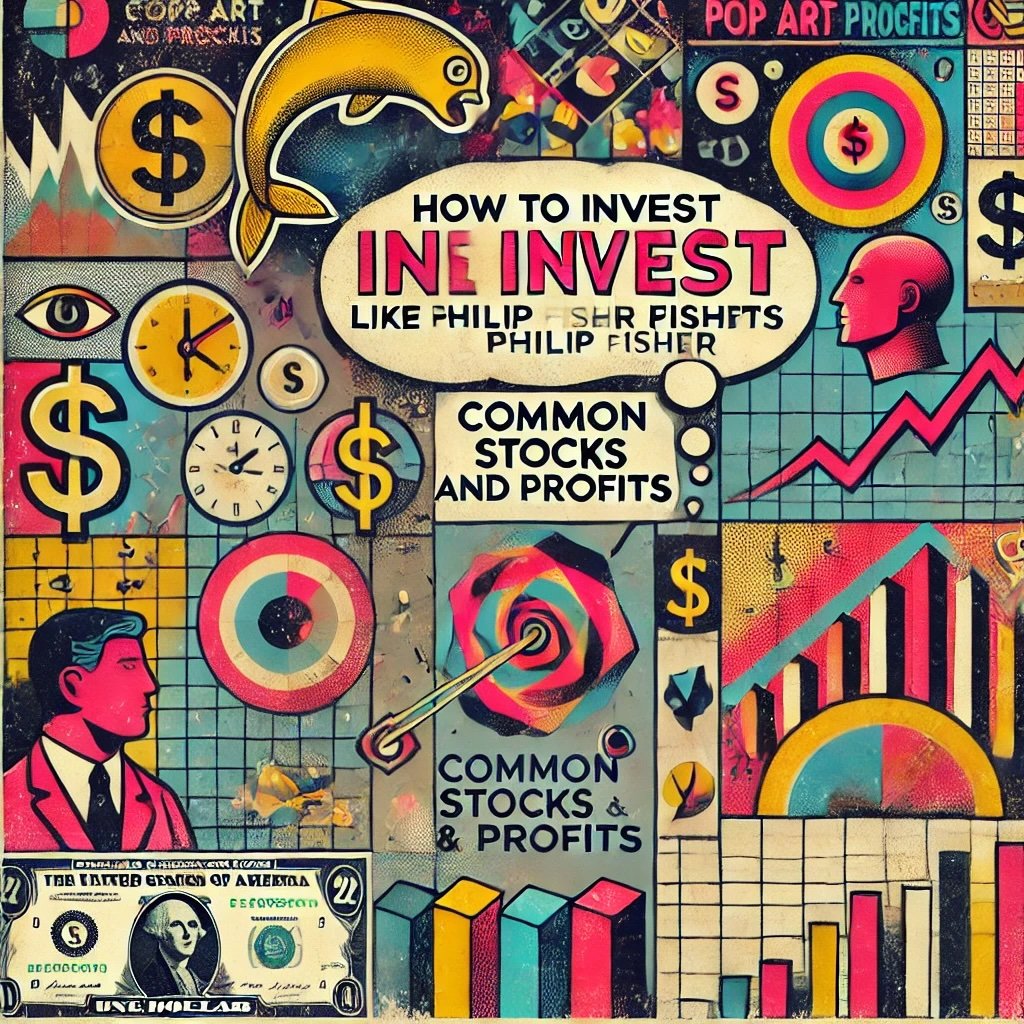Carl Icahn is one of the most renowned figures in the world of investing, especially in the realm of activist investing. With a career spanning several decades, he has built a reputation as a fierce, determined investor who is not afraid to shake up the corporate world. Known for taking significant stakes in underperforming companies, Icahn uses his influence to push for changes that benefit shareholders, often leading to substantial gains in stock value. His style is direct, his approach aggressive, and his success undeniable.
source: CNBC Television on YouTube
Over the years, Icahn has engaged in numerous high-profile battles with corporate management. From his involvement with Apple, where he pushed for stock buybacks, to his public showdown with Bill Ackman over Herbalife, Icahn’s name is synonymous with corporate reform and shareholder advocacy. He’s proven time and again that his strategy works, driving up shareholder returns by taking an active role in the companies he invests in. But Icahn’s approach isn’t just about boosting stock prices—it’s about creating long-term value by improving corporate governance, cutting costs, and focusing on the bottom line.
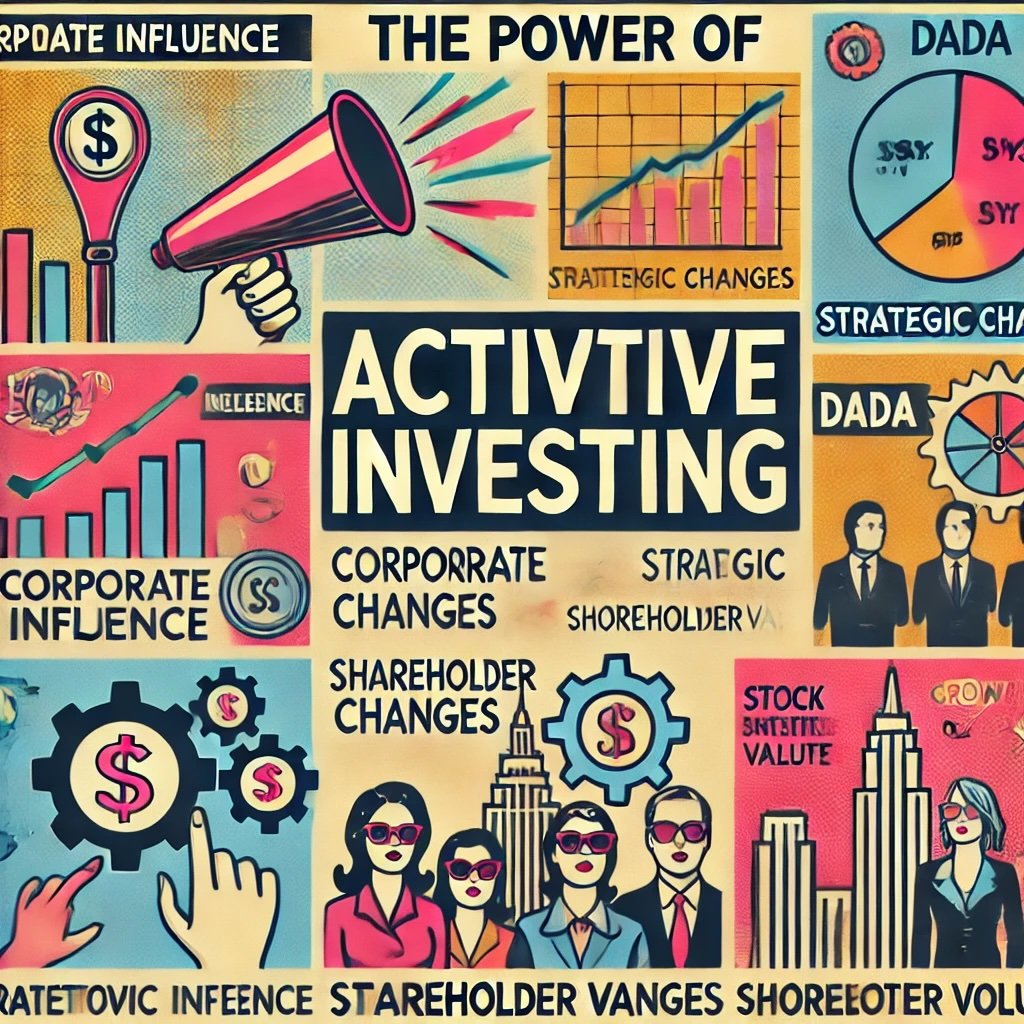
- Carl Icahn’s legacy: An activist investor with decades of success, known for pushing companies to their fullest potential.
- Notable campaigns: High-profile interventions with companies like Apple and Herbalife, among others.
- Corporate reform: Icahn’s influence often results in stronger management, better governance, and higher shareholder returns.
Tip for Best Practices: Study Icahn’s investment battles to learn how he identifies underperforming companies. Focus on his ability to spot opportunities where leadership is weak or financials are mismanaged, as this is where activist investors can make the biggest impact.
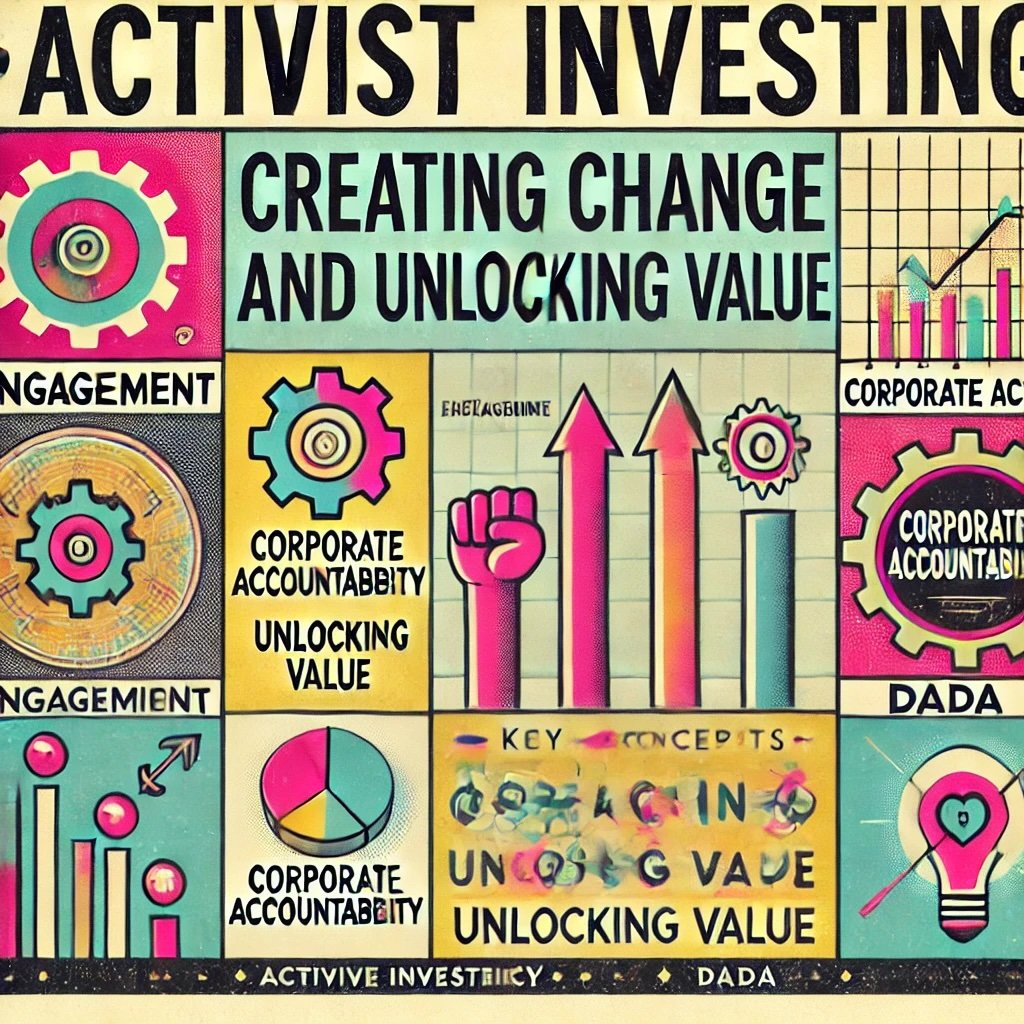
Overview of Carl Icahn
The aim here is to explore Carl Icahn’s activist investing strategies and provide investors with actionable insights on how to apply similar methods. Icahn’s approach goes beyond simply buying stocks and holding them for the long term. His method involves active engagement with the companies he invests in. He doesn’t just hope for change—he demands it. Icahn’s ultimate goal is to unlock value by making corporate boards more accountable, streamlining operations, and sometimes even advocating for mergers or divestitures.
In the traditional world of investing, many investors remain passive, holding their stocks and waiting for the market to boost prices. But activist investing is different. Activists like Icahn actively seek to create value through intervention, whether by pushing for new leadership, suggesting cost-cutting measures, or encouraging stock buybacks. This article will break down Icahn’s unique strategy, showing how his methods lead to higher returns and how these techniques can be adapted by investors at all levels.
By the end of this article, you will understand:
- What activist investing involves and how it contrasts with passive investing.
- Carl Icahn’s strategy for engaging with underperforming companies and pushing for change.
- How to apply these tactics to your own investment strategy, even if you’re not taking billion-dollar positions.
Whether you’re an individual investor looking to take a more hands-on approach with your portfolio, or simply curious about how activist investing works, this article will provide valuable insights into the world of corporate reform and shareholder advocacy.
- Active vs. Passive Investing: Learn how activists like Icahn drive change and value creation.
- Icahn’s Strategy: Discover how he identifies companies for intervention and his methods for influencing change.
- Practical Application: Tips on how to incorporate activist-style thinking into your own investments.
Tip for Best Practices: While you may not have the resources to buy a significant stake in a major company, you can still apply an activist mindset by closely analyzing management performance, board effectiveness, and company strategy before making investments.
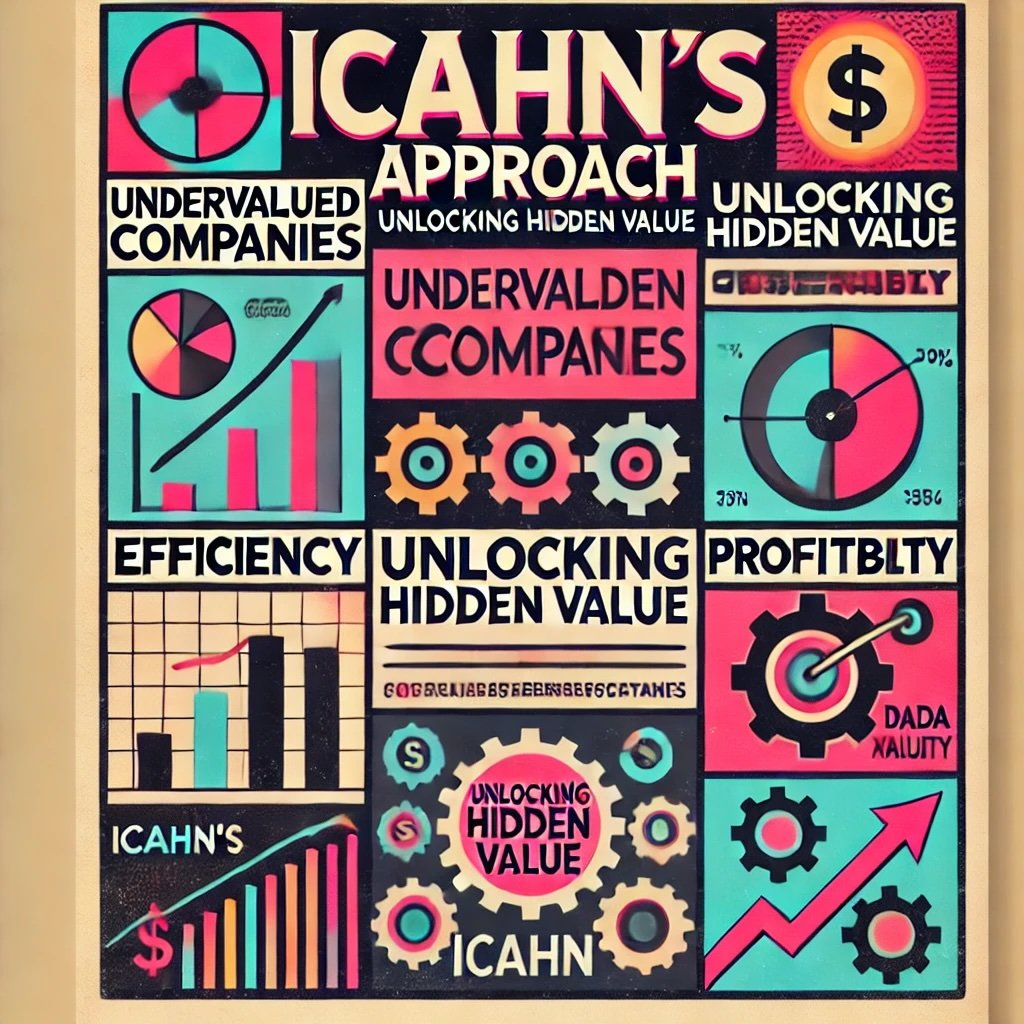
Icahn’s Approach
Carl Icahn’s approach to investing is all about unlocking hidden value. Unlike traditional investors who buy stocks and wait for market forces to push them higher, Icahn believes that many companies are undervalued due to internal mismanagement, bloated costs, or poor governance. He targets these companies, takes a substantial stake, and then uses his influence to force changes that unlock the company’s full potential. His goal is always the same: to make the company more efficient, more profitable, and ultimately more valuable.
To do this, Icahn typically starts by purchasing a significant percentage of the company’s shares—often enough to give him substantial leverage over the company’s board. With this leverage, Icahn pushes for changes such as leadership overhauls, cost-cutting measures, and sometimes even asset sales or mergers. These changes, while often controversial, are designed to benefit shareholders by improving the company’s financial performance and boosting its stock price.
One of Icahn’s most famous campaigns was his involvement with Apple. Icahn advocated for Apple to increase its stock buyback program, arguing that the company had too much cash on hand and could drive up shareholder value by returning more of that cash to investors. His public pressure on Apple’s management eventually led to the company expanding its buyback program, benefiting both Icahn and other shareholders significantly.
In other cases, Icahn has used proxy fights—campaigns where he seeks to replace board members with his own candidates—to gain greater control over a company’s direction. These tactics allow him to steer companies towards the strategic decisions he believes will create the most value for shareholders.
- Identifying Targets: Icahn looks for companies with strong fundamentals but poor management or inefficiencies.
- Influencing Change: Once he has a stake, Icahn pushes for cost reductions, leadership changes, or strategic shifts.
- Tactical Pressure: Publicly pressing for stock buybacks or changes in board structure to increase shareholder value.
Tip for Best Practices: When considering investments, look for companies with solid fundamentals that might be held back by poor leadership. Icahn’s success often comes from finding companies where better management could lead to significantly higher value.

What is Activist Investing?
Definition of Activist Investing
Activist investing is a unique approach to the stock market that goes beyond traditional investment methods. While most investors focus on buying and holding stocks with the expectation that market forces will eventually drive prices higher, activist investors take a more hands-on approach. They aim to influence how companies are managed and operated, believing that by pushing for change, they can unlock hidden value and improve the company’s overall performance.
Activist investors typically buy significant stakes in companies they believe are underperforming or undervalued due to poor management, inefficient operations, or strategic missteps. Once they acquire enough shares to have a voice, they push for corporate reforms that they believe will boost shareholder value. These reforms could include anything from leadership changes and cost-cutting measures to asset divestitures or stock buybacks.
The key difference between activist investing and traditional investing lies in the level of engagement. Traditional investors are often passive, trusting in the company’s management to run operations effectively. Activist investors, on the other hand, are proactive. They believe they can create value by stepping in and influencing the decisions made at the highest levels of the company.
- Active Engagement: Activist investors take a hands-on approach, directly influencing corporate decisions.
- Focus on Underperformance: They target companies they believe are underachieving due to poor leadership or strategic mistakes.
- Value Creation: The ultimate goal is to improve company performance and unlock hidden value.
Tip for Best Practices: If you’re considering adopting an activist mindset, look for companies with strong fundamentals that are underperforming due to poor management or strategic blunders. These are often the best targets for shareholder-driven reforms.
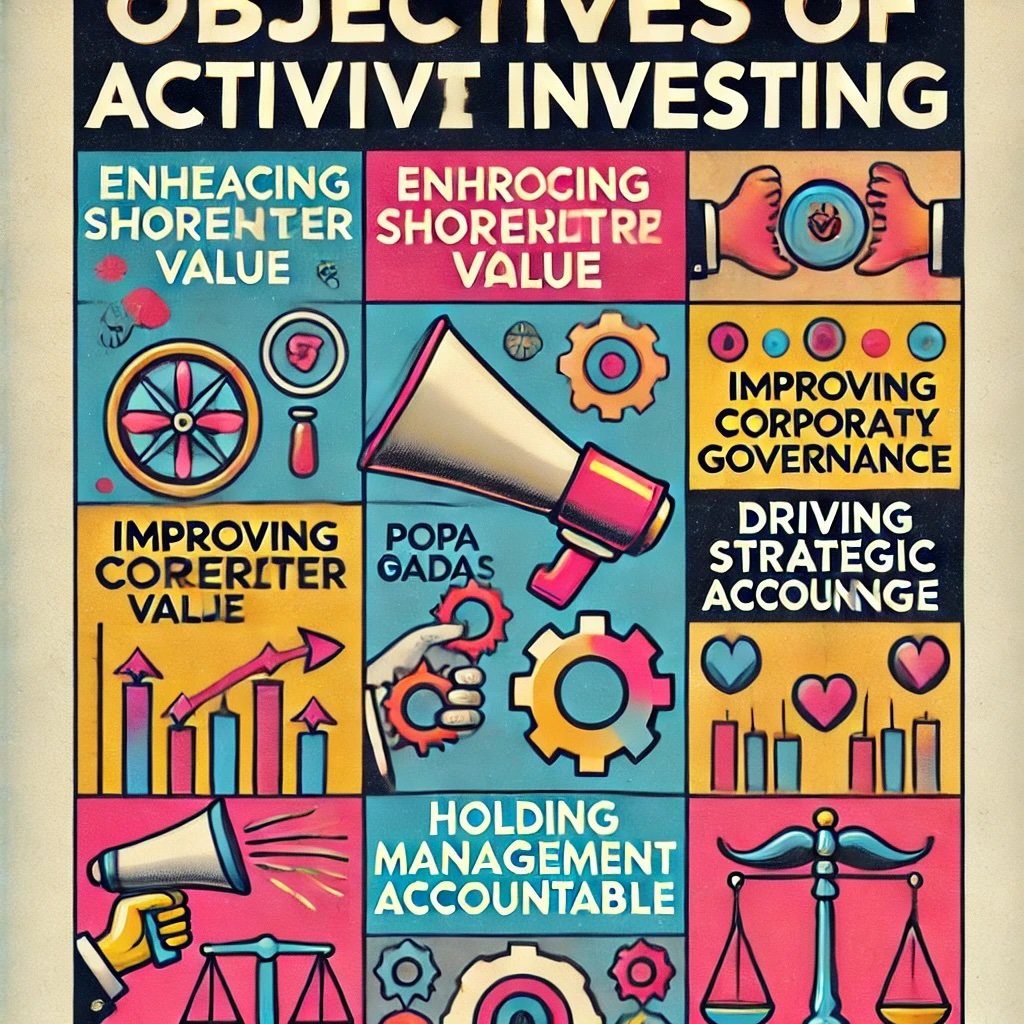
Objectives of Activist Investing
The primary objective of activist investing is to enhance shareholder value. Activist investors believe that by making certain changes within the company, they can boost the stock price and generate higher returns for themselves and other shareholders. However, improving shareholder value is only one part of the activist playbook. There are several other objectives that guide activist campaigns:
- Improving Corporate Governance: One of the key goals for activist investors is to improve how companies are governed. This could involve advocating for board changes, increasing transparency, or implementing better executive compensation structures. Activists believe that a company with strong governance is more likely to make smart, long-term decisions that benefit shareholders.
- Driving Strategic Change: Activist investors often push for companies to rethink their strategy. For example, they may advocate for cost-cutting measures, the sale of underperforming divisions, or the initiation of stock buybacks to return cash to shareholders. In some cases, activists will even push for companies to merge or be acquired by a competitor if they believe that would unlock more value.
- Holding Management Accountable: Another key objective of activist investing is to hold company management accountable. Activists believe that executive leadership must be held to high standards, and if management is not delivering results, activists will push for leadership changes. They may demand that the CEO be replaced or call for the appointment of new board members who can provide fresh perspectives and ideas.
- Enhancing Shareholder Value: The ultimate goal of activist investors is to increase the value of their shares by improving company performance.
- Corporate Governance: Advocating for better governance, including board changes and executive compensation reform.
- Strategic Shifts: Pushing for cost cuts, stock buybacks, or mergers to create value.
Tip for Best Practices: To adopt an activist mindset, pay close attention to how the company is governed. Look for opportunities where changes in the board structure or leadership could lead to better decision-making and improved performance.
Icahn’s Impact on Activist Investing
When it comes to activist investing, few names are as well-known or influential as Carl Icahn. Over the course of his career, Icahn has become synonymous with shareholder activism, leading numerous high-profile campaigns to reshape underperforming companies. His ability to spot undervalued companies and then push for changes that dramatically boost their value has made him one of the most successful investors of all time.
Icahn’s approach to activist investing is simple yet effective: He identifies companies that are mismanaged or operating inefficiently, acquires a large stake, and then uses his influence to force strategic changes. In many cases, these changes include reducing excessive costs, selling off non-core assets, or initiating stock buybacks. Icahn has also been known to engage in proxy battles, where he attempts to replace board members with his own nominees in order to gain greater control over the company’s direction.
One of the most famous examples of Icahn’s activist success is his involvement with Apple Inc. In 2013, Icahn took a significant stake in the tech giant and publicly pushed for the company to return more cash to shareholders by increasing its stock buyback program. After months of lobbying and public pressure, Apple agreed to expand its buyback initiative, returning billions of dollars to investors. Icahn’s involvement helped boost Apple’s stock price, earning him—and other shareholders—significant returns.
Another high-profile campaign was Icahn’s battle over Herbalife. Icahn took a large stake in the company and publicly defended its business model against accusations from fellow billionaire Bill Ackman, who had taken a large short position against the company. Icahn’s involvement helped drive up Herbalife’s stock price, proving his ability to rally shareholder support and turn the tide in public opinion.
- Apple Campaign: Icahn successfully pushed Apple to expand its stock buyback program, leading to significant gains for shareholders.
- Herbalife Battle: Icahn’s defense of Herbalife against Bill Ackman’s short position resulted in a dramatic increase in the company’s stock price.
- Proxy Battles: Icahn is known for engaging in proxy fights to replace board members and gain influence over a company’s direction.
Tip for Best Practices: Take note of Icahn’s ability to spot undervalued companies with strong potential. His success often comes from pushing for changes that other investors may not have the influence or insight to pursue. Look for companies where management isn’t delivering results and consider how an activist approach could unlock value.
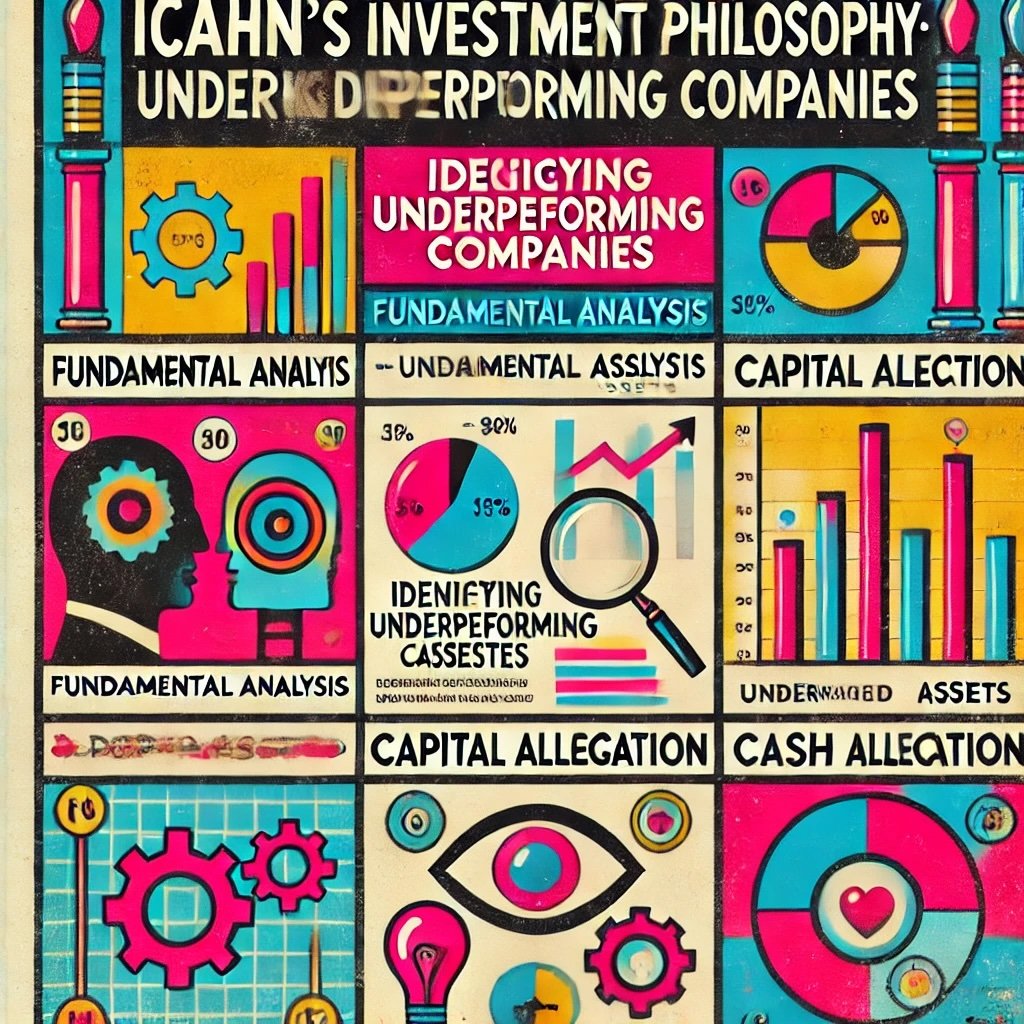
Icahn’s Investment Philosophy
Identifying Underperforming Companies
At the core of Carl Icahn’s investment philosophy is his ability to identify underperforming companies with strong potential for value creation. Icahn has an eye for spotting firms that are mismanaged, inefficient, or undervalued by the market. His strategy begins by thoroughly analyzing a company’s fundamentals—examining its financial health, leadership quality, competitive position, and growth potential. For Icahn, the key is to find companies that have solid core assets but are being held back by poor decision-making or inefficient operations.
Often, these companies have underwhelming stock performance, not because their products or services are inferior, but because their leadership isn’t maximizing the value of their assets. Icahn sees these companies as opportunities where small, targeted interventions can lead to significant returns. He looks for businesses that are either sitting on untapped resources, have bloated operational costs, or are simply lagging due to ineffective governance.
One of Icahn’s strategies is to focus on companies with strong cash flow but poor capital allocation. He’s particularly drawn to firms that hoard cash without reinvesting it in growth opportunities or returning it to shareholders. This often leads to him pushing for stock buybacks or higher dividends, unlocking immediate value for shareholders. Icahn also targets companies with valuable but underperforming divisions—those that would benefit from being spun off or sold to streamline operations.
- Fundamental Analysis: Icahn looks at the company’s financials, cash flow, and leadership quality.
- Undervalued Assets: He focuses on companies with strong assets that are not being used to their full potential.
- Capital Allocation: Icahn often identifies firms with poor capital allocation, pushing them to reinvest or return cash to shareholders.
Tip for Best Practices: Look for companies that are lagging in stock performance due to poor capital allocation or mismanagement, but have strong underlying assets. These are often prime candidates for intervention and value creation.
Gaining Strategic Influence
Once Icahn identifies an underperforming company, the next step is gaining influence. Icahn is known for taking large stakes in the companies he targets, which gives him leverage to push for changes. Typically, he’ll acquire enough shares to gain a significant voting block, allowing him to influence major decisions at shareholder meetings. He often aims for a stake large enough to get a seat at the board table, but not so large that it limits his flexibility.
With a substantial stake in hand, Icahn then begins advocating for strategic changes. These changes could include pushing for the replacement of underperforming executives, advocating for the appointment of new board members who align with his vision, or calling for a restructuring of the company’s operations. Icahn is also known for engaging in proxy battles, where he campaigns to replace board members with his own nominees if the existing management resists his ideas.
In many cases, Icahn uses his public platform to apply pressure. He’s not afraid to issue public statements criticizing a company’s leadership or outlining the reforms he believes are necessary to unlock value. This public pressure often brings other shareholders on board, increasing the likelihood that management will take his recommendations seriously.
Icahn’s reputation as a fearless and aggressive activist investor also works in his favor. When Icahn takes a stake in a company, both management and the market take notice. His presence alone often signals to the market that changes are coming, which can lead to an immediate rise in stock price as investors anticipate value creation.
- Large Stake Acquisition: Icahn buys a significant portion of a company’s stock to gain voting power and influence.
- Board Changes: He often pushes for new board members or engages in proxy battles to replace ineffective leadership.
- Public Pressure: Icahn leverages media and public opinion to advocate for the changes he wants to see.
Tip for Best Practices: When investing in a company, consider whether gaining a significant stake or aligning with other large shareholders could give you the leverage needed to push for meaningful changes.
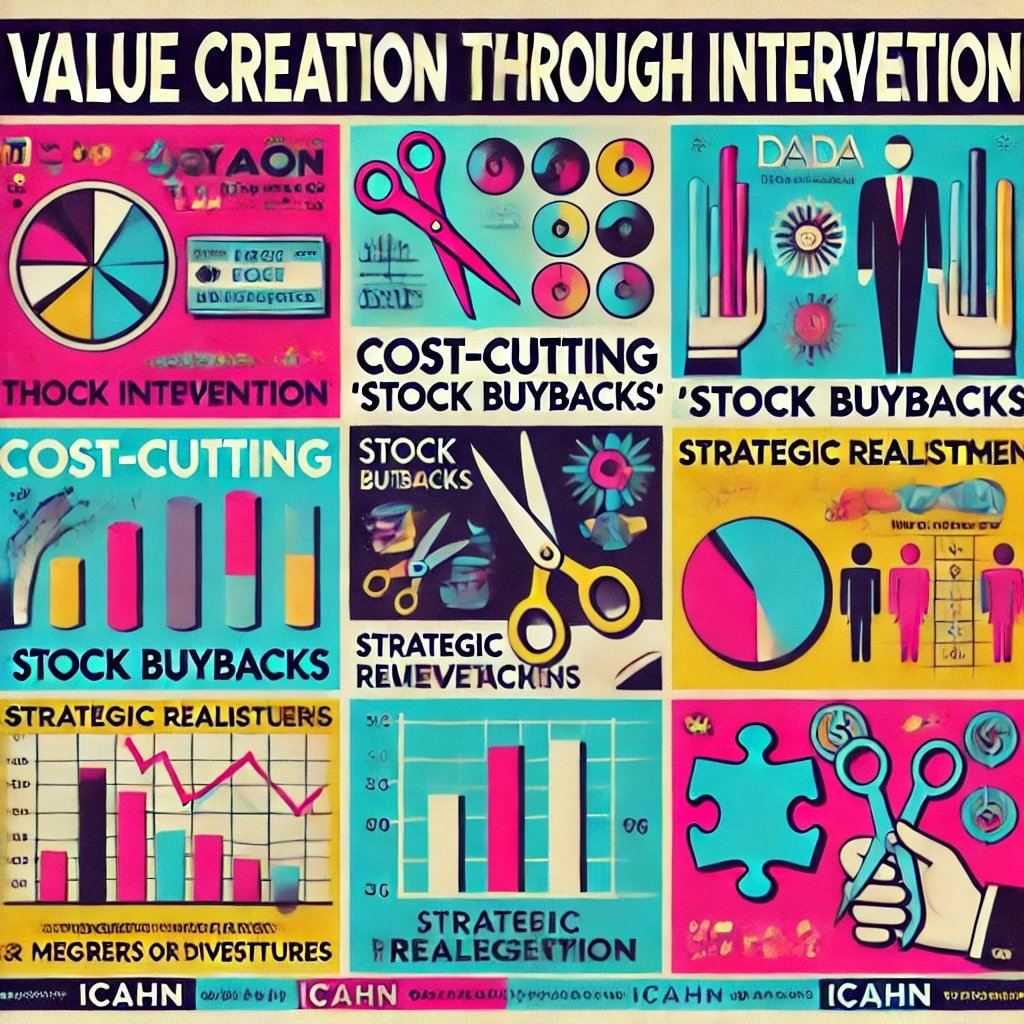
Value Creation Through Intervention
The ultimate goal of Icahn’s investment strategy is to unlock shareholder value. He believes that through targeted interventions, companies can be transformed into more efficient, profitable, and valuable entities. Icahn’s interventions typically take the form of cost-cutting measures, operational restructuring, or strategic realignment.
For example, Icahn often advocates for streamlining operations by cutting unnecessary expenses or selling off non-core business units. By focusing the company on its most profitable segments, he helps improve margins and drive higher earnings. Icahn is also a strong proponent of stock buybacks. He frequently pushes companies to return excess cash to shareholders through buybacks, which reduces the number of outstanding shares and increases the value of each remaining share.
In some cases, Icahn has pushed for mergers or acquisitions when he believes that combining two companies would create synergies and unlock further value. This was the case with CVR Energy, where Icahn’s influence led to discussions of a potential sale or merger, boosting the company’s stock price.
Icahn’s interventions often lead to immediate gains for shareholders, but his focus is on long-term value creation. He doesn’t just aim for short-term stock price increases—he wants to ensure that the company is positioned for sustainable growth in the future.
- Cost-Cutting: Icahn often advocates for reducing expenses and streamlining operations to improve profitability.
- Stock Buybacks: He pushes for companies to return cash to shareholders through buybacks, increasing stock value.
- Strategic Realignment: Icahn may call for divestitures, mergers, or other strategic changes to unlock long-term value.
Tip for Best Practices: When evaluating companies for potential investment, consider whether there are opportunities for cost reductions, strategic shifts, or capital returns that could significantly increase shareholder value.

The Power of Influence in Activist Investing
Board Representation
One of Carl Icahn’s most powerful tools in activist investing is securing board representation. By gaining seats on a company’s board, Icahn and his allies are able to directly influence the strategic direction of the company. This is often a key step in his efforts to reshape underperforming businesses and unlock shareholder value. Icahn’s strategy is simple: if you want to make changes from the inside, you need a seat at the table.
When Icahn acquires a substantial stake in a company, one of his first moves is often to lobby for board representation. Having board members who are aligned with his vision allows him to influence important decisions such as CEO appointments, corporate restructuring, and financial policies. With a seat on the board, Icahn can make sure that management is accountable to shareholders and that decisions are being made with the goal of maximizing shareholder returns.
This strategy has been highly effective for Icahn in numerous campaigns. For example, his push for representation on the board of Yahoo allowed him to drive significant changes in the company’s leadership and strategic direction. By having allies on the board, Icahn ensured that the company took a more aggressive approach to unlocking value, ultimately resulting in the sale of Yahoo’s core business.
- Securing Board Seats: Icahn lobbies for representation on the board to directly influence corporate strategy.
- Direct Influence: Once on the board, Icahn can shape decisions on leadership, operations, and financial policies.
- Holding Management Accountable: Board representation allows Icahn to ensure management is working in the best interests of shareholders.
Tip for Best Practices: Even if you don’t have the power to secure a board seat like Icahn, pay attention to the composition of a company’s board. A strong, shareholder-focused board can make a big difference in long-term value creation.

Proxy Fights
When management resists Icahn’s proposals, he doesn’t hesitate to engage in proxy fights. Proxy battles are one of the more aggressive tactics in activist investing and involve trying to replace board members by rallying other shareholders to vote for Icahn’s nominees. The goal is to remove executives or board members who oppose his strategic vision and replace them with individuals who are aligned with his ideas for creating value.
Proxy fights can be messy, public, and contentious. They often draw considerable media attention, as Icahn battles it out with entrenched management for control over the company’s direction. These fights are about more than just seats on the board—they’re about shaping the future of the company. For Icahn, winning a proxy battle means gaining the leverage needed to implement major changes, such as leadership overhauls or asset divestitures.
One famous proxy fight Icahn engaged in was at Dell Technologies in 2013. Icahn opposed the company’s plan to go private, arguing that it undervalued the company and wasn’t in the best interests of shareholders. He launched a proxy fight to block the deal, calling on shareholders to vote against it. Although Icahn ultimately didn’t prevail in this instance, the battle highlighted his willingness to fight for shareholder interests and challenge management’s decisions when he believes they are wrong.
- Proxy Fights: Icahn engages in battles to replace board members with his own nominees when management resists his ideas.
- Shareholder Support: Proxy battles are about rallying shareholders to vote for Icahn’s nominees and strategic vision.
- Influence over Company Direction: Winning a proxy fight gives Icahn the power to implement significant changes at the company.
Tip for Best Practices: Proxy fights are rare for individual investors, but you can still make your voice heard by voting your shares at annual meetings. Always review proxy materials to ensure that you’re voting in line with your interests.
Public Pressure
Another hallmark of Icahn’s strategy is his ability to leverage public pressure. Icahn is a master of using the media to shape public perception and sway investor sentiment. By making bold public statements—often critical of management—he draws attention to the issues within a company and builds support for his proposed changes. This public scrutiny can put immense pressure on management to comply with his demands or face a potential shareholder revolt.
Icahn’s use of media is particularly effective because it often leads to an immediate reaction in the stock price. When Icahn makes a public announcement criticizing a company’s management or outlining his plan for value creation, the market listens. Investors know Icahn’s track record and often buy into his vision, leading to a rise in the company’s stock price as shareholders anticipate change. This, in turn, puts more pressure on the company to follow Icahn’s lead.
A clear example of this was Icahn’s campaign against eBay in 2014. Icahn publicly criticized eBay’s leadership, particularly its decision not to spin off PayPal. By airing his grievances in the media and calling for the PayPal spin-off, Icahn rallied investors to his side. The public pressure became too much for eBay’s management, and the company eventually agreed to spin off PayPal, resulting in a substantial rise in both companies’ stock prices.
- Media Influence: Icahn uses public statements to criticize management and build support for his vision.
- Market Reaction: Icahn’s announcements often lead to a rise in stock prices as investors anticipate changes.
- Shaping Public Perception: Public pressure makes it difficult for management to ignore Icahn’s demands.
Tip for Best Practices: Keep an eye on public statements from influential activist investors like Icahn. Their opinions can often signal upcoming changes that could impact the company’s stock price.
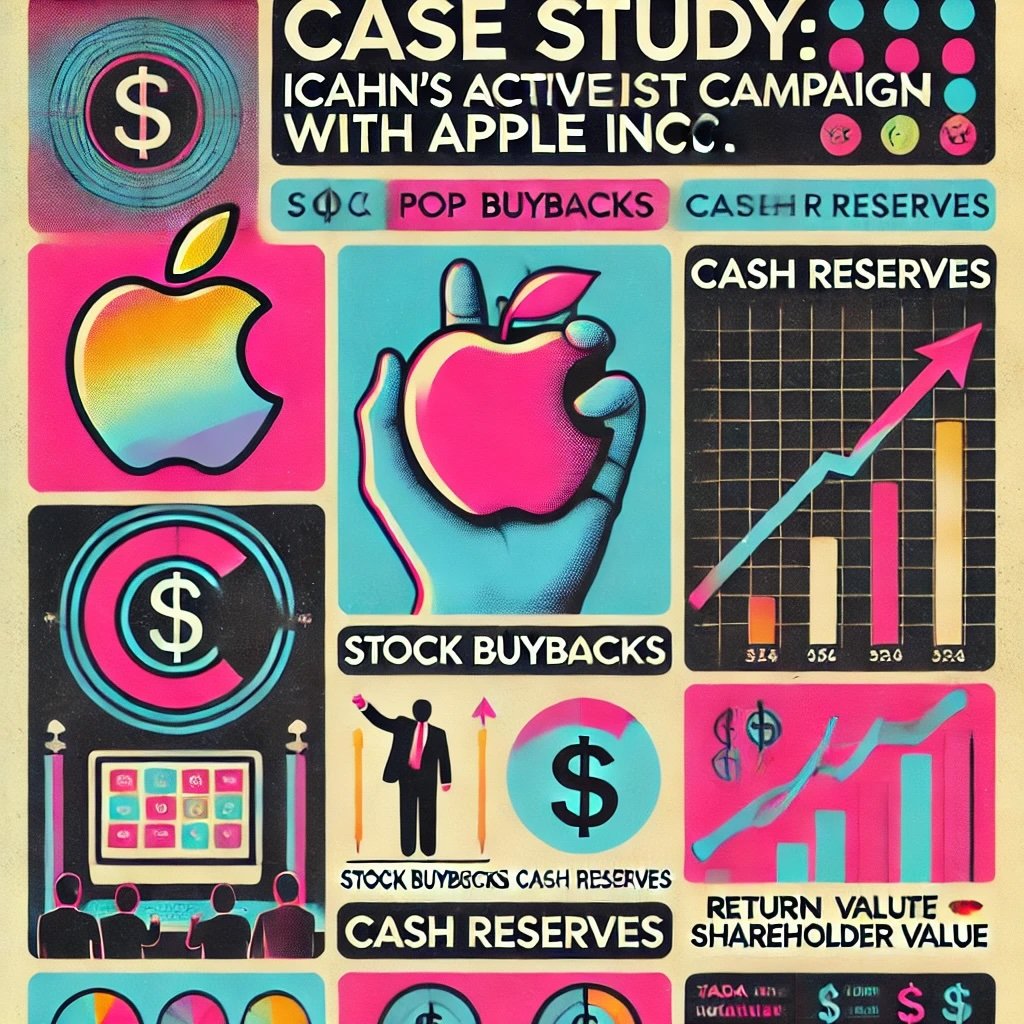
Case Studies of Icahn’s Activist Campaigns
Case Study 1: Apple Inc.
Carl Icahn’s campaign with Apple Inc. is one of his most famous and impactful activist endeavors. In 2013, Icahn began building a significant stake in the tech giant, which was already a well-established leader in innovation and profitability. Despite its success, Icahn saw an opportunity to unlock even more value for shareholders. His primary argument? Apple was sitting on a massive cash reserve that could be used to benefit shareholders through stock buybacks and dividend increases.
Icahn publicly pushed for Apple to expand its stock buyback program, believing that by repurchasing shares, the company would reduce the number of shares outstanding, thereby increasing the value of each remaining share. Icahn communicated this proposal directly to Apple’s CEO Tim Cook, while also using the media to generate public pressure. His view was that Apple’s stock was significantly undervalued relative to its enormous cash reserves and earnings power.
After months of lobbying, Apple eventually expanded its stock buyback program, returning billions of dollars to shareholders. This move not only boosted Apple’s stock price but also solidified Icahn’s reputation as a powerful force in shareholder activism. Icahn eventually sold his stake in Apple at a significant profit, stating that the company had fully addressed his concerns about capital allocation.
- Icahn’s Focus: Pushed for Apple to increase stock buybacks to return more cash to shareholders.
- Outcome: Apple expanded its buyback program, resulting in a rise in its stock price and substantial returns for shareholders.
- Icahn’s Influence: His public campaign and direct engagement with Apple’s leadership led to real changes in the company’s capital strategy.
Tip for Best Practices: Pay attention to how much cash companies are sitting on. Like Icahn, you can identify opportunities where a company could return excess cash to shareholders, potentially increasing stock value.
Case Study 2: Netflix
In 2012, Icahn made another high-profile investment—this time in Netflix, a company that many investors had doubts about at the time. Netflix’s stock had dropped sharply after the company’s botched attempt to separate its DVD and streaming services, and many questioned its ability to compete with major media companies. But Icahn saw something that others missed: Netflix’s potential as a disruptor in the media industry.
Icahn began purchasing Netflix shares when they were trading at a low price, ultimately acquiring a 10% stake in the company. He believed that Netflix was undervalued due to its potential for growth in the streaming space and even suggested that the company could be an acquisition target for tech giants like Google or Amazon. Icahn’s entry into Netflix brought attention to the company, and his endorsement signaled confidence in its business model.
Rather than pushing for immediate changes, Icahn allowed Netflix’s management to continue executing their vision. The company’s aggressive investment in original content, along with the expansion of its streaming service, helped skyrocket Netflix’s stock price. By 2015, Icahn began selling his stake in Netflix, realizing a massive profit.
Netflix’s success highlighted Icahn’s ability to spot potential in companies before the market fully recognized it. While other investors were skeptical, Icahn’s belief in Netflix’s disruptive capabilities paid off handsomely.
- Icahn’s Insight: Saw Netflix’s potential in the streaming market, even when others were uncertain.
- Outcome: Netflix’s stock soared as the company grew, and Icahn sold his shares for a substantial profit.
- Strategic Patience: Icahn didn’t push for drastic changes but allowed Netflix’s management to continue their strategy, which proved successful.
Tip for Best Practices: Look beyond current challenges a company might face. Like Icahn with Netflix, consider the long-term growth potential in sectors that are undergoing disruption.

Case Study 3: Herbalife
One of the most dramatic and public battles in Icahn’s career involved Herbalife, a global nutrition company. In 2012, fellow billionaire and activist investor Bill Ackman took a short position in Herbalife, claiming that the company was operating a pyramid scheme and predicting its collapse. Ackman’s very public attack on Herbalife caused its stock to fall, and he made it clear that he was betting on the company’s failure.
Icahn, however, saw things differently. He believed that Herbalife was a legitimate business and that Ackman’s claims were overblown. Icahn took a large long position in Herbalife, setting the stage for a high-profile showdown between the two investors. Icahn not only defended Herbalife’s business model but also publicly challenged Ackman, turning the dispute into a major media spectacle.
Icahn’s involvement helped stabilize Herbalife’s stock, as his endorsement brought confidence to the market. Over time, Herbalife’s financial performance improved, and the company ultimately reached a settlement with regulators that allowed it to continue operating. Icahn’s bet on Herbalife paid off, and the company’s stock price rebounded, delivering significant gains for Icahn and other shareholders.
The Herbalife saga demonstrated Icahn’s willingness to go against the grain and defend companies that he believes in, even in the face of intense public scrutiny.
- Icahn’s Stance: Took a long position in Herbalife and publicly defended the company against accusations from Bill Ackman.
- Outcome: Herbalife’s stock price rebounded, and Icahn made a substantial profit from his investment.
- Media and Market Impact: Icahn’s public battle with Ackman drew significant attention, further solidifying his role as a leading activist investor.
Tip for Best Practices: Sometimes going against the crowd can pay off. Don’t be afraid to back a company that’s under attack if you believe in its long-term potential.
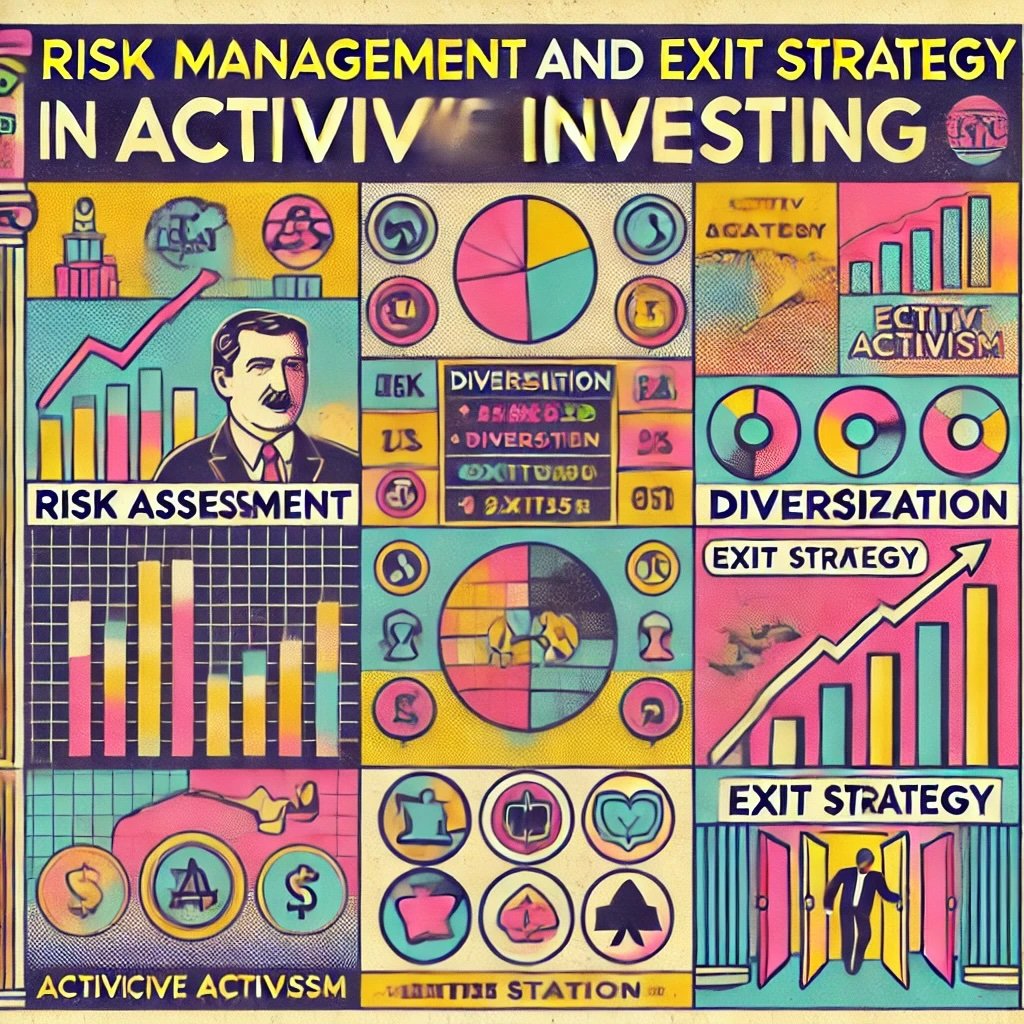
Risk Management and Exit Strategy in Activist Investing
Risk Assessment
Carl Icahn is known for his aggressive and hands-on approach to investing. But even for a seasoned activist investor like him, risk assessment plays a critical role. Before diving into a new position, Icahn carefully evaluates the risks associated with his potential investment. He doesn’t just look at a company’s financials—he digs deep into the company’s management structure, corporate governance, and overall market environment.
One of the primary risks in activist investing is management resistance. When Icahn takes a position in a company, he often faces pushback from corporate leaders who resist his proposals for restructuring or leadership changes. This resistance can lead to protracted battles that consume both time and resources. Icahn is well aware of this, and he calculates how much time and energy it might take to overcome these obstacles before committing to a position. He evaluates how entrenched the current management is, whether they are open to change, and how much support he’s likely to get from other shareholders.
Another key risk is market volatility. Activist investing is not immune to the ups and downs of the broader market. If Icahn takes a large position in a company and the market tanks, his investment could suffer regardless of the changes he pushes for. To account for this, Icahn tends to focus on companies with strong fundamentals that are likely to weather market turbulence better than others. He also keeps a close eye on industry trends and how macroeconomic conditions could affect his investment.
- Management Resistance: Icahn assesses how likely management is to push back against his proposed changes.
- Market Volatility: He factors in broader market risks and focuses on companies with strong fundamentals to reduce the impact of market swings.
- Support from Shareholders: Icahn evaluates whether he can rally enough shareholder support to successfully implement his strategy.
Tip for Best Practices: When evaluating the risk of an activist position, consider how resistant management might be to your proposals and whether you can garner enough support from other shareholders to make an impact.
Diversification
Despite his high-conviction bets on individual companies, Icahn understands the importance of diversification in managing risk. While activist investing often involves taking significant stakes in a few companies, Icahn mitigates his exposure by diversifying across industries. His portfolio typically includes investments in sectors ranging from technology and energy to consumer goods and pharmaceuticals. This cross-industry diversification allows Icahn to spread risk, ensuring that a downturn in one sector doesn’t devastate his entire portfolio.
For example, while Icahn has been heavily involved in companies like Apple and Netflix, which are part of the tech and media sectors, he also maintains investments in energy companies like Occidental Petroleum and CVR Energy. This diversified approach protects his overall portfolio from sector-specific downturns. If the tech sector were to experience a slump, his energy or healthcare holdings might still perform well, helping to balance the risk.
Additionally, Icahn often diversifies not just by industry but also by company size. He invests in large-cap companies that are established industry leaders, but he also finds opportunities in mid-cap or smaller companies where he can have a more direct influence and potentially see greater upside.
- Cross-Industry Investments: Icahn diversifies across sectors like technology, energy, and consumer goods to manage risk.
- Company Size: He balances his portfolio with investments in both large-cap companies and smaller firms where he can have a more direct influence.
- Sector Resilience: Icahn ensures that his portfolio isn’t overly exposed to one sector, allowing him to ride out downturns in individual industries.
Tip for Best Practices: Diversification is key to managing risk, even in activist investing. Spread your investments across multiple sectors and consider companies of different sizes to reduce your exposure to any one industry.
Exit Strategy
One of the most important components of activist investing is knowing when to exit. Icahn has built his success not just by identifying underperforming companies but by having a clear exit strategy in place. His approach is always focused on creating shareholder value, and he knows that the time to sell is when he has achieved his objectives or when the company has hit a valuation that no longer justifies holding the stock.
There are a few key exit strategies that Icahn employs. In some cases, Icahn exits a position after achieving desired corporate changes. For example, if he pushes for board representation, restructuring, or a stock buyback, and the company implements these changes, he may choose to sell his shares at a premium once the market recognizes the value of these reforms. This allows him to realize a profit while leaving the company in a better position than when he first invested.
Another exit strategy involves mergers and acquisitions. If Icahn believes that a company’s value could be maximized through a sale or merger, he pushes for such deals. Once the deal is completed and shareholders receive a premium on their shares, Icahn exits his position. This approach often yields significant profits, as companies are typically sold at a higher price than their current stock value.
Finally, Icahn is not afraid to exit a position if it no longer aligns with his vision or if the market conditions have changed. He closely monitors his investments and reassesses his position regularly. If the risks begin to outweigh the potential rewards, Icahn has no qualms about cutting his losses and moving on to the next opportunity.
- Corporate Changes: Icahn exits once his proposals, such as stock buybacks or board changes, have been implemented and the company’s value has increased.
- Mergers and Acquisitions: He pushes for mergers or sales and exits once the deal is completed and shareholders have received a premium.
- Market Reevaluation: Icahn exits positions when market conditions change, or the investment no longer aligns with his objectives.
Tip for Best Practices: Always have a clear exit strategy before you invest. Know what your goals are, whether it’s pushing for corporate changes, waiting for a merger, or selling once the company reaches a certain valuation.
How to Invest Like Carl Icahn — 12-Question FAQ (Activist Investing, Simplified)
What is activist investing in plain English?
It’s a hands-on strategy where investors buy meaningful stakes in public companies and push for change—from governance fixes to capital allocation moves—to unlock shareholder value.
How does Carl Icahn typically create value?
He targets undervalued, underperforming companies with fixable problems, amasses influence, and presses for cost cuts, buybacks/dividends, asset sales, spin-offs, M&A, and board/leadership changes to improve returns.
What traits does Icahn look for in a target?
Strong core assets and cash flow, poor capital allocation, bloated costs, governance gaps, non-core assets that could be sold, and a realistic path to re-rating once reforms are implemented.
How can a non-billionaire apply an “Icahn mindset”?
Screen for firms with high cash balances, weak ROIC vs peers, misaligned pay plans, or persistent value gaps; use your vote, support credible board slates, and size positions prudently within a diversified portfolio.
What tools do activists use to gain influence?
Open letters, 13D filings, proxy contests, board nominations, settlement agreements, media campaigns, and coalition-building with other shareholders and proxy advisors.
Are buybacks always good (Icahn’s frequent ask)?
They’re powerful when shares are truly undervalued and core operations are funded; they destroy value if used at peak valuations or at the expense of necessary investment and balance-sheet resilience.
How do proxy fights actually change outcomes?
Securing board seats changes who sets strategy—capital allocation, CEO selection, M&A, incentive plans—turning ideas into enforceable policies rather than hopeful suggestions.
What are the biggest risks of activist investing?
Management entrenchment, drawn-out legal/process costs, timing risk, value traps, adverse cycles, and reputational overhang if campaigns become combative or fail.
What metrics signal activism could work here?
Growing free cash flow, sum-of-the-parts discounts, chronic conglomerate discounts, negative TSR vs peers despite decent unit economics, and governance red flags (staggered boards, weak independence).
How long should you give an activist thesis?
Expect a multi-quarter to multi-year arc: identify → influence/settlement → implement changes → financials improve → multiple re-rates. Monitor milestones, not headlines.
How do you risk-manage an activist position?
Cap position sizes, diversify across sectors and catalysts, define pre-mortems (what must go right), set time-boxed checkpoints, and be willing to exit on broken milestones.
What’s a simple “Icahn-lite” playbook I can use?
Screen for cash-rich laggards with fixable governance; 2) build a starter position; 3) vote your proxy and support credible reforms; 4) track capital allocation shifts; 5) scale only as milestones are met.
Important Information
Comprehensive Investment Disclaimer:
All content provided on this website (including but not limited to portfolio ideas, fund analyses, investment strategies, commentary on market conditions, and discussions regarding leverage) is strictly for educational, informational, and illustrative purposes only. The information does not constitute financial, investment, tax, accounting, or legal advice. Opinions, strategies, and ideas presented herein represent personal perspectives, are based on independent research and publicly available information, and do not necessarily reflect the views or official positions of any third-party organizations, institutions, or affiliates.
Investing in financial markets inherently carries substantial risks, including but not limited to market volatility, economic uncertainties, geopolitical developments, and liquidity risks. You must be fully aware that there is always the potential for partial or total loss of your principal investment. Additionally, the use of leverage or leveraged financial products significantly increases risk exposure by amplifying both potential gains and potential losses, and thus is not appropriate or advisable for all investors. Using leverage may result in losing more than your initial invested capital, incurring margin calls, experiencing substantial interest costs, or suffering severe financial distress.
Past performance indicators, including historical data, backtesting results, and hypothetical scenarios, should never be viewed as guarantees or reliable predictions of future performance. Any examples provided are purely hypothetical and intended only for illustration purposes. Performance benchmarks, such as market indexes mentioned on this site, are theoretical and are not directly investable. While diligent efforts are made to provide accurate and current information, “Picture Perfect Portfolios” does not warrant, represent, or guarantee the accuracy, completeness, or timeliness of any information provided. Errors, inaccuracies, or outdated information may exist.
Users of this website are strongly encouraged to independently verify all information, conduct comprehensive research and due diligence, and engage with qualified financial, investment, tax, or legal professionals before making any investment or financial decisions. The responsibility for making informed investment decisions rests entirely with the individual. “Picture Perfect Portfolios” explicitly disclaims all liability for any direct, indirect, incidental, special, consequential, or other losses or damages incurred, financial or otherwise, arising out of reliance upon, or use of, any content or information presented on this website.
By accessing, reading, and utilizing the content on this website, you expressly acknowledge, understand, accept, and agree to abide by these terms and conditions. Please consult the full and detailed disclaimer available elsewhere on this website for further clarification and additional important disclosures. Read the complete disclaimer here.



